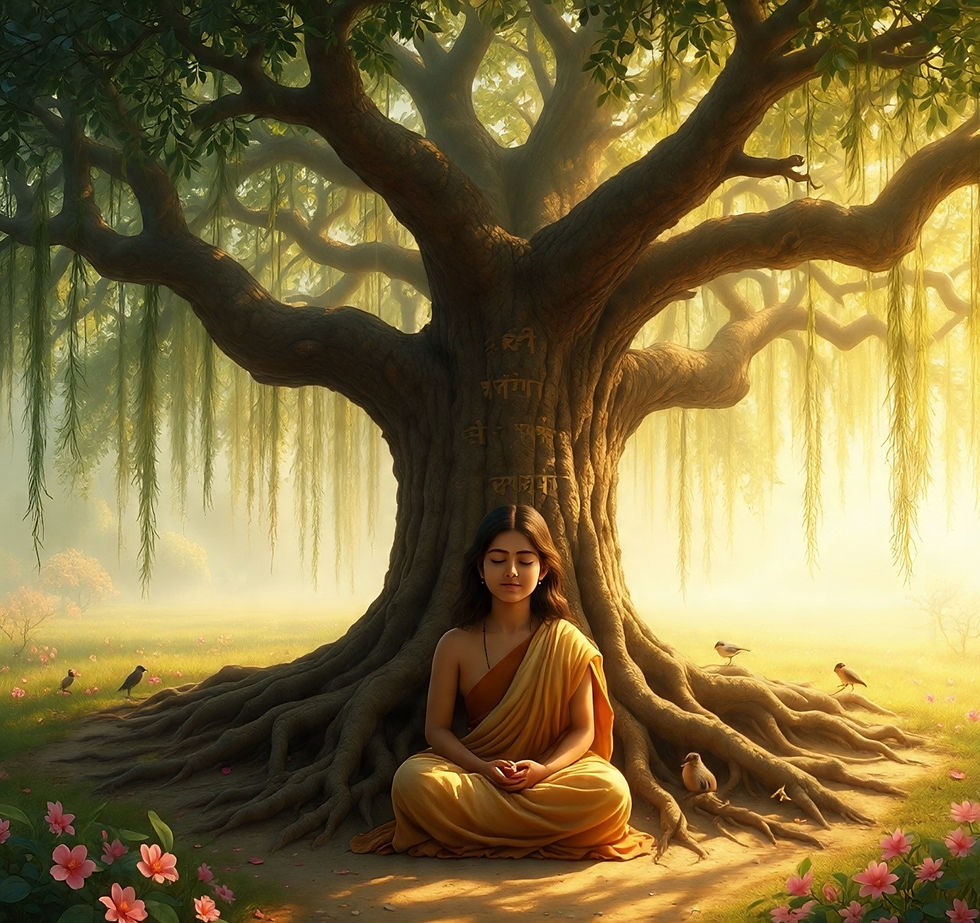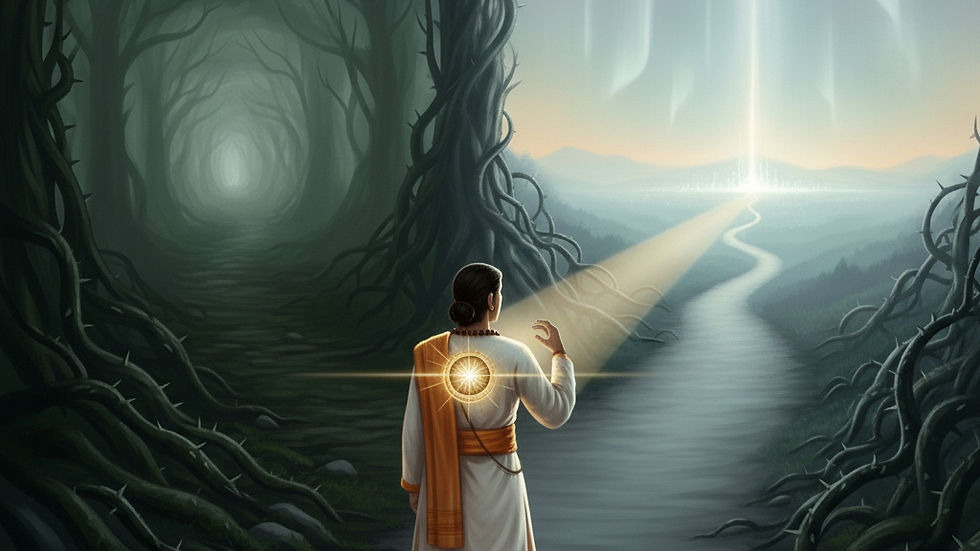The Deep Roots of Life: Why Trees Matter as Sacred Companions
- H.H. Raseshwari Devi Ji

- Aug 7
- 4 min read
Updated: Sep 10

Introduction: A Prayer Beneath the Shade
Not all compassion wears a face. Some of it stands quietly, rooted in the soil, offering shade to strangers, fruit to the hungry, and breath to all who live. Trees are not passive ornaments of our landscapes. They are sentient companions — patient, generous, and profoundly alive.
In an age of steel towers and virtual clouds, the ancient, leafy arms of trees still reach out to us, reminding us of something eternal. Not just oxygen or beauty — but the essence of unconditional giving.
A single mature tree can provide enough oxygen for two people each day — and yet, it never asks for thanks. Beneath their canopies, cities breathe easier, hearts slow down, and children play. Forests are not just the "lungs of the Earth"; they are the gentle breath of life itself. When we inhale deeply under a tree, something within us calms — not just because of science, but because the soul recognizes a presence it trusts.
More Than Carbon Sinks — They Are Empaths in Bark and Leaf
It’s common to praise trees for absorbing carbon and cleaning the air — and indeed, they do. But that is only the surface. Trees don’t just cleanse the air; they soften our minds. Have you ever wept quietly under a tree’s shade? Or sat beneath its branches during heartbreak? Trees don’t interrupt. They listen. In their stillness, they absorb more than pollution — they absorb sorrow, too. A tree is a silent therapist, rooted in compassion.
Where trees flourish, the Earth holds firm. Their roots cradle the soil, drink the rain, and weave networks beneath our feet that stabilize the land. Their presence attracts clouds, anchors aquifers, and prevents both flood and famine. When a tree falls, it is not just timber lost — it is a mother’s arm withdrawn from a trembling child.
A Refuge for the Forgotten
A tree is not just a home for birds. It is a universe of life. Moths, monkeys, mushrooms, bees, squirrels, serpents — a single tree sustains hundreds of species, seen and unseen. And what does it ask in return? Nothing. Not even an acknowledgement. To chop a tree without need is not simply deforestation. It is an eviction. It is erasure.
In India’s villages, the neem or banyan tree is often older than the homes that surround it. Children are named under it. Elders rest beside it. Disputes are settled in its shade. It witnesses generations. It gives without pride. It stands without fear. It grows without hurry. To sit beneath such a tree is to be in the presence of a wise elder — one who says nothing, yet teaches everything.
Trees in Sanātana Dharma: Living Deities
Our scriptures never reduced trees to “natural resources.” They saw them as venerable beings. Vṛkṣa Pūjā — the act of worshiping trees — was not symbolic. It was sincere. The peepal tree is associated with Lord Vishnu. The banyan, with eternal life. The tulsi plant is revered as a goddess. Circumambulating a tree, offering water to its roots, or touching its bark with reverence — these were not empty rituals. They were recognitions of divinity in living form.
Solutions Rooted in Relationship
We don’t just need more trees. We need a new relationship with them. One rooted in gratitude, care, and spiritual kinship.
Plant with Love
Choose native trees. Learn their stories. Celebrate their birthdays like family members.
Protect What Protects You
Stand up for threatened forests. Support urban green spaces. Speak for trees when they cannot speak for themselves.
Live Lightly
Avoid products that cause deforestation. Use paper sparingly. Say no to unnecessary timber and palm oil.
Teach with Reverence
Help children form friendships with trees — not just knowledge. Let them name the tree they planted. Let them talk to it.
Restore Sacred Practices
Revive Vṛkṣa Pūjā (Tree Worship). Offer water to trees daily. Make it an act of prayer, not utility.
Conclusion: The Soul of the Forest Speaks Without Words
A tree does not preach. It simply is — giving, growing, sheltering, enduring. It reminds us of virtues we often forget: patience, humility, rootedness, compassion. When we revere trees not for their use but for their presence, something shifts inside us. We stop seeing them as scenery and start seeing them as sacred.
As the Taittirīya Upaniṣad teaches:
"Yathā vṛkṣa-mūlani śiśicati svayam eva upayāti rasaḥ | Evam eva sarvān imān prajāḥ samāni annam āharanti devānām iti."
— Taittirīya Upaniṣad, III.10
Just as water poured at a tree’s root nourishes the entire tree, when the needs of all beings are served with harmony, the divine is truly worshipped.
Let us not wait for forests to vanish before we recognize their soul.Let every tree be seen not as a commodity — but as a companion in the dance of life.
With love and reverence,
Radhe Radhe,
— Raseshwari Devi Ji
Further Reading:
(Environmental Role: Responsibility and Stewardship)
“मानव जीवन में प्रकृति का महत्व” (Importance of Nature in Human Life)
“जीवन में पर्यावरणीय जिम्मेदारी” (Environmental Responsibility in Life)
“मानव जीवन और वृक्षों का महत्व” (The Value of Trees in Human Life)
“प्रकृति के साथ सामंजस्य: मानव का धर्म” (Harmony with Nature: A Human Duty)
“प्रकृति संरक्षण के बिना मानव जीवन अधूरा है” (Human Life Is Incomplete Without Nature Conservation)
Frequently Asked Questions
Q1. Are trees really aware of us?
Yes. Scientific studies show trees communicate, respond to threats, and form networks. Spiritually, trees are conscious beings — they feel, adapt, and bless silently.
Q2. How can I form a personal connection with a tree?
Sit with it. Touch its bark. Offer water. Give it a name. Share your thoughts with it. Trees don’t speak — but they do respond.
Q3. What are examples of sacred trees in Indian tradition?
Peepal (aśvattha), banyan (vaṭa), neem, kadamba, tulsi, and bilva trees are all revered in Sanātana Dharma. Many are associated with specific deities or holy acts.
Q4. Is planting enough, or do we need to protect existing trees?
Both are vital. But protection is even more important. A 50-year-old tree cannot be replaced by 50 saplings. Every mature tree is an elder — and elders must be protected, not replaced.





















Comments